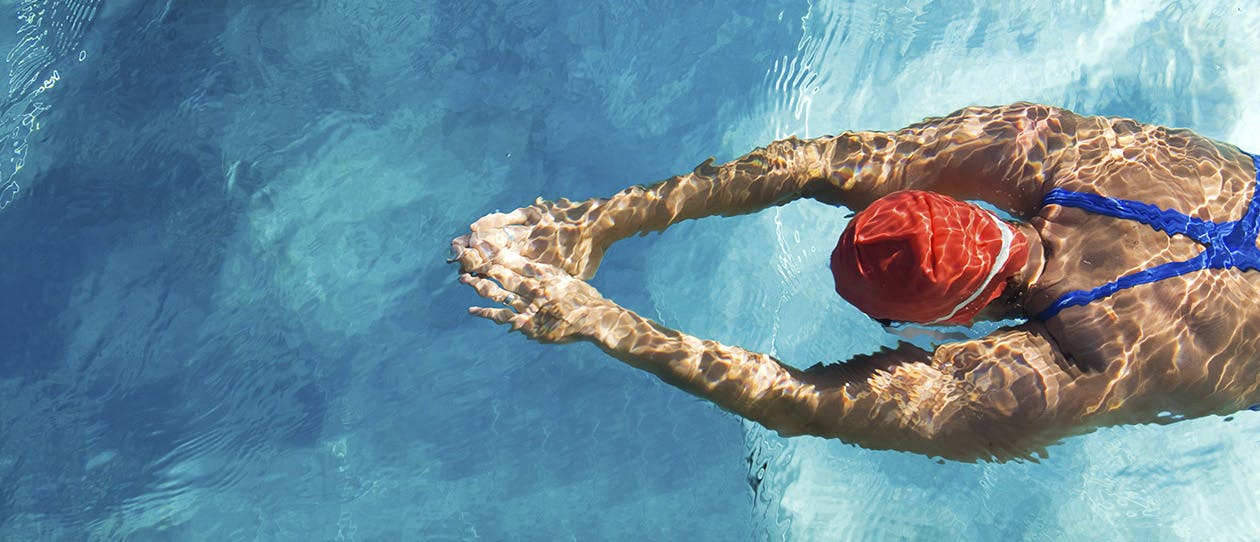Swimming and weight loss
Swimming is a great form of exercise for people who are overweight, who have knee, hip or ankle problems, or who want to maintain a healthy level of body fat.
It targets all the major muscle groups as the body moves against the resistance of the water, helping to burn off kilojoules and boost your cardiovascular fitness. It places vigorous demands on your heart and lungs without impact or jarring on your joints.<.br>
However, because the water supports your weight, swimming may not burn as many kilojoules as weight bearing exercises on land, such as fast walking or running. The trick is to incorporate a few simple training strategies to maximise the effect of slimming and fat loss from swimming.
Strive to swim faster
The faster you swim in a given amount of time, the more kilojoules you’ll burn.
To measure your progress, set a distance, time or lap challenge that fits in with your schedule, and your training goals. Racing against the clock in a weekly personal best swim is a great way to boost your motivation and performance.
For example, if you intend to train for 30 minutes, see how many laps you can complete in that time. Then, continually strive to beat your best effort, which is great form of goal setting. You’ll need to work progressively harder and faster to achieve your best, but by doing so, you will force your body to change.
If you feel like you are not progressing with your swimming, or if you aren’t losing any weight, don’t be afraid to seek professional help. A swim coach or squad can offer guidance on training and technique, and teach you how to execute your stroke with greater efficiency.
Do plenty of freestyle
There are a variety of swimming techniques to choose from, including breaststroke, sidestroke, backstroke and butterfly. Deep water running is also a challenging technique, and good for variety.
While all the different strokes work your body in slightly different ways, the best overall stroke to focus on for training, kilojoule burning, and muscle toning is freestyle.
When you consider that the bigger the muscle use, the greater the kilojoule burn, then freestyle wins hands down. In addition to your upper body, try to really work the larger muscles in your legs and buttocks while you swim, using your feet like flippers. Keep your legs straight and your feet flexible, making a scissors-type movement to power you forwards through the water.
Don’t just be a swimmer
The best form of exercise over the long-term is the type you enjoy, and are most likely to stick to. If you enjoy swimming, it is a worthy addition to any exercise program.
But if your goal is to lose body fat, don’t just rely on swimming as your only form of exercise. Look to include additional weight bearing exercises to up your fat burning workouts , such as fast walking or running.
For example, you may like to walk for 20 minutes, and swim afterwards for 20 minutes, or you may wish to alternate days, swimming one day and walking the next. As your body fat levels reduce, you could try to swim more and walk less, adjusting your program depending on the changes to your body shape. This method of alternating activities is known as cross training, and can help boost motivation while reducing your risk of overuse injuries.
Include short, intense bursts
Interval training can dramatically boost the kilojoule burning, fat burning and fitness benefits of swimming. Using structured bursts of very fast swimming followed by active recovery periods gives you variety and makes swimming far more effective for weight control.
For example, warm up for 3 – 5 minutes, and then swim a very fast lap of freestyle. You should feel puffed and in need of a breather, but don’t stop. Swim a slow lap of breaststroke to recover, and then repeat 5 – 10 times, depending on your level of fitness.
This is an advanced training technique that you can perform 2-3 times a week which allows you to focus on both fitness (fast pace) and technique (recovery pace). Just make sure to establish a good base of fitness over a month or two before you commence interval training.

